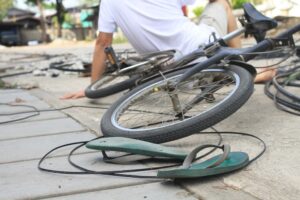How Can a Lawyer Help After Suffering a Head Injury in a Bicycle Accident?
How Can a Lawyer Help After Suffering a Head Injury in a Bicycle Accident?
Serious accidents happen when people drive recklessly and carelessly, especially in the presence of bicycles. Moreover, when a bicyclist falls to the ground in an accident, they may strike their head with a significant amount of force, resulting in a traumatic head or brain injury. Even when bicyclists wear helmets, the helmet may crack during a sufficiently forceful accident.
When a bicycle rider suffers head injuries in an accident, they can recover compensation from the at-fault party’s insurance company. A skilled bicycle accident attorney in your area can assist in securing the relief needed for you to regain financial stability.
How Do Head Injuries Happen in Bicycle Crashes?

Head injuries in bike accidents can occur in several ways, often resulting from the forceful impact between the cyclist’s head and another object. One common scenario is a collision with a motor vehicle. If a car strikes a cyclist, the collision may cause the cyclist’s head to hit the vehicle, the ground, or other surfaces, leading to head injuries.
A cyclist can also fall from the bike due to sudden stops, obstacles, or uneven surfaces. The force of hitting the ground, pavement, or other hard objects can result in head injuries. Cyclists who are not wearing helmets or wearing improperly fitted helmets are particularly vulnerable to head trauma in these situations.
In addition, obstacles on the road, such as potholes, debris, or road hazards, can contribute to head injuries. A cyclist encountering unexpected obstacles may lose balance, leading to a fall and subsequent head injury. In other cases, bike accidents occur due to the negligence of other road users, such as reckless drivers, distracted motorists, or those who fail to yield the right-of-way. These negligent actions can lead to collisions, causing the cyclist to sustain head injuries.
Common Causes of Local Bike Accidents
Bicycle accidents resulting from others’ negligence have various causes, reflecting the complex interactions between cyclists and other road users. One common cause is distracted driving. Motorists who engage in activities such as texting, talking on the phone, or using in-car entertainment systems divert their attention from the road, increasing the risk of colliding with cyclists. Distracted driving compromises a driver’s ability to observe and respond to the presence of cyclists, contributing to accidents.
Failure to yield is another prevalent form of negligence leading to bicycle accidents. Motorists may neglect to yield the right-of-way at intersections, crosswalks, or when making turns, putting cyclists in danger. This failure to acknowledge cyclists’ rights on the road can result in collisions, especially when drivers do not give cyclists the appropriate space and consideration.
Inadequate awareness and understanding of bicycle lanes contribute to accidents. Motorists may encroach on designated bike lanes, either unintentionally or negligently, not realizing the potential dangers this poses to cyclists. Failure to respect the designated space for cyclists can lead to sideswipe or dooring incidents, whereby a driver opens a car door into the path of an oncoming cyclist.
Speeding and reckless driving significantly increase the risk of bicycle accidents. Excessive speeds reduce a driver’s reaction time and the ability to stop suddenly, making it more challenging to avoid collisions with cyclists. Aggressive driving behaviors, such as tailgating or weaving in and out of traffic, create unsafe conditions for cyclists sharing the road.
Poor road maintenance and inadequate infrastructure also contribute to bike accidents. Potholes, uneven surfaces, or lack of proper signage can create hazards for cyclists. In areas without well-maintained bike paths or designated cycling lanes, cyclists often share narrow roads with fast-moving vehicles, amplifying the risk of accidents.
Understanding the different causes of bicycle accidents resulting from others’ negligence emphasizes the need for comprehensive road safety measures. Promoting awareness, adhering to traffic rules, and advocating for cyclist-friendly infrastructure are crucial steps in reducing the incidence of accidents caused by the negligence of other road users.
Where Can Bike Accidents Happen?
Bike accidents resulting from others’ negligence can occur in various locations, with certain areas more prone to such incidents due to specific characteristics and traffic dynamics. Urban areas with heavy traffic are often hotspots for bike accidents. The combination of congested streets, many intersections, and a mix of vehicles and cyclists increases the likelihood of collisions. Negligent actions by motorists, such as distracted driving or failure to yield, contribute significantly to accidents in urban settings.
Intersections, regardless of location, are particularly susceptible to bicycle accidents. The convergence of different roadways and the need for cyclists to navigate through traffic elevate the risk of collisions. Motorists may fail to yield the right-of-way to cyclists, leading to hazardous situations at intersections.
Residential neighborhoods, typically with lower speed limits, are not immune to bicycle accidents caused by others’ negligence. In these areas, drivers may be far less vigilant due to a perceived lower level of risk. Negligent actions such as speeding or failing to observe stop signs can result in serious accidents involving cyclists.
Bicycle lanes, designed to enhance cyclist safety, can paradoxically be sites of accidents due to negligence. Some motorists may disregard designated bike lanes, merging them without proper caution. Additionally, obstacles within bike lanes or poor maintenance of these paths can pose hazards to cyclists.
Rural or suburban areas present a different set of challenges. Roads with higher speed limits and limited cycling infrastructure may expose cyclists to increased risks. Lack of awareness or inattentiveness by drivers on rural roads can contribute to bicycle accidents.
Parking lots and driveways are additional locations where bicycle accidents may occur. Motorists backing out of parking spaces or driveways may overlook cyclists approaching from behind, leading to collisions.
Understanding the common areas where bike accidents due to others’ negligence are most prevalent is crucial for motorists. Promoting awareness, responsible driving behavior, and adherence to traffic rules can create safer environments and reduce the risks associated with bicycle accidents.
Legally Proving a Bike Accident Case
Establishing a legal case for a head injury resulting from negligence in a bicycle accident demands a careful approach and the presentation of compelling evidence. The accident victim’s attorney must demonstrate the legal elements of duty, breach of duty, causation, and damages to establish liability and seek fair compensation for the injured party.
- Duty of Care — The lawyer begins by establishing that the responsible party owed a duty of care to the cyclist. This duty encompasses the obligation to act reasonably and avoid causing harm.
- Breach of Duty — The attorney must then show that the responsible party breached their duty of care, leading to the head injury. This may involve presenting evidence of specific negligent actions, such as distracted driving, failure to yield, or other reckless behavior. Eyewitness accounts, traffic camera footage, or professional testimony can strengthen the case by illustrating the breach of duty.
- Causation — The injured person’s attorney must establish a direct link between the breach of duty and the head injury the cyclist suffered. This requires demonstrating that the negligent actions were a substantial factor in causing the accident and subsequent harm. Medical records, diagnostic reports, and professional opinions (especially from skilled physicians) can be pivotal in establishing the connection between the accident and the head injury.
- Damages — The lawyer documents and quantifies the damages resulting from the head injury. This includes medical expenses, rehabilitation costs, lost income, pain and suffering, and other relevant financial losses. Thorough medical records, bills, employment records, and professional testimony can help build a comprehensive case for damages.
To strengthen the legal proof, the injured person’s attorney can include the following:
- Medical Documentation — The victim’s lawyer will obtain detailed medical records outlining the nature and extent of the head injury. This may include diagnostic tests, treatment plans, and prognosis.
- Professional Medical Testimony — The injured person’s lawyer can engage medical professionals who can provide professional opinions on the causation and long-term effects of the head injury. Their testimony can carry significant weight in establishing the link between the accident and the injury.
- Eyewitness Testimony — The lawyer will collect statements from eyewitnesses who can attest to the events leading up to the accident and the negligent actions of the responsible party.
- Traffic Camera Footage — If available, the victim’s attorney will review any traffic camera footage capturing the accident. Visual evidence can be powerful in illustrating the circumstances and fault in the incident – especially during a jury trial.
A knowledgeable bicycle accident attorney can present a compelling case on behalf of the injured cyclist, seeking justice and fair compensation for the cyclist’s head injury.
How Can a Lawyer Assist?
Engaging a personal injury lawyer is crucial after suffering a head injury in a bike accident caused by someone else’s negligence, as these legal professionals play a pivotal role in protecting your rights, navigating complex legal processes, and securing fair compensation. Here is how a personal injury lawyer can assist:
- Case Assessment — A lawyer will thoroughly assess the circumstances surrounding your bike accident and head injury. They will evaluate the evidence, such as medical records, eyewitness statements, and accident reports, to determine the strength of your case and identify liable parties.
- Legal Expertise — Personal injury lawyers focusing on navigating the legal intricacies of personal injury cases, including bike accidents and head injuries. They understand the applicable laws, regulations, and precedents, providing you with a knowledgeable guide through the legal system.
- Establishing Fault — Proving negligence is a key aspect of a personal injury case. Your lawyer will work to establish that the responsible party had a duty of care, breached that duty, and directly caused your head injury. This involves gathering evidence, interviewing witnesses, and consulting professionals when necessary.
- Emotional Support — Dealing with the aftermath of a head injury can be emotionally challenging. A personal injury lawyer provides support, guidance, and reassurance throughout the legal process, allowing you to focus totally on your medical recovery.
- Calculating Damages — Personal injury lawyers are adept at assessing the damages you have suffered, including medical expenses, lost income, pain and suffering, and potential future costs related to the head injury. Accurate calculation of damages is essential for seeking fair compensation.
- Negotiating with Insurance Companies — Dealing with insurance companies can be complex and challenging. Your lawyer will manage communications, negotiations, and settlement discussions with the at-fault party’s insurer. They will work to secure a settlement that adequately covers your losses.
- Navigating Legal Deadlines — Personal injury cases are subject to statutes of limitations, which impose deadlines for filing claims. A lawyer promptly files all necessary legal documents, preventing potential issues related to missed deadlines.
- Litigation Representation — If the parties fail to reach a fair settlement, your lawyer will be ready to take your case to court. They will handle the legal proceedings, present evidence, examine witnesses, and advocate for your rights during the bench or jury trial.
Engaging a personal injury lawyer is a crucial step in seeking justice and fair compensation after suffering a head injury in a bike accident caused by someone else’s negligence. Their experience and advocacy can significantly enhance your chances of a successful outcome in your personal injury claim.
Recovering Financial Compensation for a Bicycle-accident Head Injury

Damages for a head injury suffered in a bike accident can encompass various categories, aiming to compensate the injured party for the losses incurred due to the negligence of another. Common categories of damages include:
- Medical Expenses — Economic damages include all current and future medical expenses related to the head injury. This covers hospitalization, surgeries, diagnostic tests, medications, rehabilitation, therapy, and other necessary medical treatments.
- Future Earning Capacity — In cases where the head injury leads to a diminished ability to earn income in the future, your lawyer can pursue economic damages to compensate for the loss of future earning capacity.
- Lost Income — If the head injury prevents you from working temporarily or permanently, economic damages can include compensation for lost income. This covers the income you will have earned during the recovery period or for your inability to work.
- Damage to Property — If the bike accident also damaged your bicycle or other personal property, repairing or replacing these items is part of your economic damages.
- Loss of Enjoyment of Life — If the head injury significantly affects your ability to engage in activities you previously enjoyed, your attorney may seek non-economic damages to compensate for this loss of life enjoyment.
- Pain and Suffering — Non-economic damages address the intangible losses resulting from the head injury. Pain and suffering compensation aims to redress the physical and emotional distress resulting from the head injury, including chronic pain, discomfort, and emotional anguish.
- Loss of Consortium — In cases where the head injury affects your relationships, non-economic damages may address the loss of consortium, including the effects on spousal companionship, support, and relationships.
Successfully recovering damages for a head injury in a bike accident requires a comprehensive assessment of both economic and non-economic losses. An experienced personal injury lawyer can help evaluate the full extent of your damages, negotiate with insurance companies, and pursue a fair settlement or litigation result to ensure that you receive just compensation for the harm you suffered.

Keith More, Bicycle Accident Attorney
Speak with an Experienced Bike Accident Lawyer Today
If you suffered a head injury in a recent bicycle accident, you need to take legal action right away. Otherwise, you may inadvertently waive your right to recover compensation under the state statute of limitations. An accident victim can begin an investigation and file a legal claim on your behalf, seeking the compensation you deserve for your injuries.


